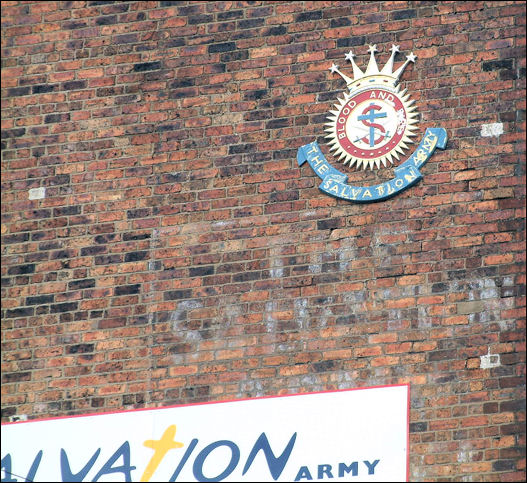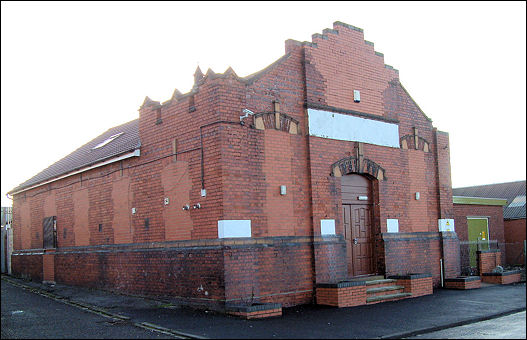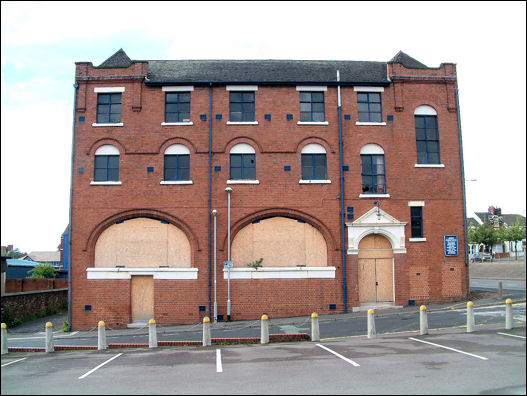|
The Salvation Army
in Stoke-on-Trent

LONGTON. A Salvation Army
barracks in Stafford Street was registered for worship in October
1884. It was probably superseded in December of the same year by a
barracks in Stone (now Lightwood) Road, which was closed in 1910
on the opening of the Salvation Army Hall in Commerce Street.
FENTON. The Primitive Methodist
Chapel in Canning Street was registered for worship by the Salvation
Army in 1885, but was superseded in 1912 by the Salvation Army
Citadel in Fountain Street.

former Salvation
Army Citadel, Fountain Street, Fenton
STOKE. A Salvation Army
barracks in Wharf Street was registered for worship in 1895.
In 1916 it was superseded by a Salvation Army hall at 30 Cross
Street, Stoke. In the same year the group moved back to a building
in Wharf Street and in 1932 to the present hall in Fletcher
Road, Stoke. The Divisional Headquarters of the Army for North
Staffordshire is in Church Street, Stoke.
STOKE, BOOTHEN. A mission room
was registered for worship by the Salvation Mission in 1892. The
registration was cancelled in 1922.
HANLEY, GLASS STREET. Batty's
Circus in Tontine Street was registered for worship by the Salvation
Army in 1881. It was probably superseded in 1882 by the Imperial
Circus, Glass Street, which in turn gave way in 1903 to the present
Salvation Army Citadel in Glass Street.

former Salvation
Army Citadel, Glass Street, Hanley
HANLEY, NEW HALL STREET. A
Salvation Army barracks in New Hall Street was registered for
worship in 1889. It had ceased to be used by 1903.
HANLEY, JOINER'S SQUARE. A
Salvation Army hall in Palmerston Street was registered for worship
in 1932. It was still in use in 1958.
BURSLEM, CORPORATION STREET. A
mission room in Corporation Street was registered for worship by the
Salvation Mission in 1883. It had ceased to be used by 1884.
BURSLEM, MOORLAND ROAD. A
mission hall in Moorland Road was registered for worship by the
Salvation Mission in 1884. It had ceased to be used by 1896.
BURSLEM, MIDDLEPORT. A
Salvation Army hall in Brindley Street was registered for worship in
1903. The registration was cancelled in 1906.
BURSLEM, WESTPORT ROAD. A
Salvation Army temple in Hall Street was registered for worship in
1903. This was replaced in 1914 by a Salvation Army temple in
Newcastle Street, and in 1933 the latter was superseded by the
Salvation Army Hall, 12 Westport (formerly Liverpool) Road.
TUNSTALL, SNEYD STREET. A
Salvation Army barracks, later designated a hall, in Sneyd Street
(now Ladywell Road) was registered for worship in 1882.
TUNSTALL, GOLDENHILL. A
Salvation Army hall at 34 High Street was registered for worship in
1933. The registration was cancelled in 1941.
SMALLTHORNE. A Salvation Army
hall in Camp Road was registered for worship in 1925.
From: 'The city of Stoke-on-Trent:
Protestant Nonconformity',
A History of the County of Stafford: Volume 8 (1963)
|
![]()